HAZRAT TIPPU SULTAN SHAHEED (RA)
by Mohammad Sharif
| Tipu Sultan ٹیپو سلطان ಟಿಪ್ಪು ಸುಲ್ತಾನ್ |
|||||
|---|---|---|---|---|---|
| Badshah Nasib ad-Dawlah Fath Ali Khan Bahadur |
|||||
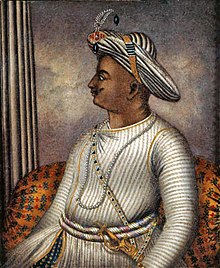 |
|||||
| Sultan of Mysore | |||||
| Reign | 29 December 1782 – 4 May 1799 | ||||
| Coronation | 29 December 1782 | ||||
| Predecessor | Hyder Ali | ||||
| Successor | Krishnaraja Wodeyar III | ||||
| Born | 20 November 1750[1] Devanahalli, present-dayBangalore, Karnataka |
||||
| Died | 4 May 1799 (aged 48) Srirangapatna, present-day Karnataka |
||||
| Burial | Srirangapatna, present-day Karnataka 12°24′36″N 76°42′50″ECoordinates: 12°24′36″N 76°42′50″E |
||||
|
|||||
| House | Mysore | ||||
| Father | Hyder Ali Khan | ||||
| Mother | Fatima Fakhr-un-Nisa | ||||
| Religion | Islam | ||||

Tippu Sultan Gombaz Srirangapatnam
” TIPPU SULTAN SHAHEED-E-AKBAR SHOUD ”
” DAKHIL-E-MEHFIL-E-PAYAMBAR SHOUD ”
( By : Allama Iqbal Rahmatullah Allaih )
Place / Town / City : Srirangapatnam
( 6kms from Mysore and 120 kms from Bangalore )
District : Mandya District
State : Karnataka.

Famous Portrait of Hazrat Tippu Sultan Shaheed Rahmatullahi Allaih (1750-1799)
Childhood and Parentage :-
Hazrat Tipu Sultan Shaheed (RA) was the son of Hazrat Haider Ali (RA) and Hazrata Fathima Begum (RA) born on 20th November 1750 A.D. at Devanahalli in Bangalore District. Hazrat Haider Ali (RA) named his son after a great Sufi saint namely Tippu Mastaan Aulia Rahmatullahi Allaih whose dargah shareef is Arcot.
THE IMPORTANT PLACES, DARGAHS, AULIYAS RELATED TO HAZRATH TIPPU SULTAN SHAHEED ( RAHMATHULLAH ALAIH ) :-
1) Shahi Gumbaz Where The Mazar-e-Shareef Of Hazrat Hyder Ali (RA), Hazratha Fathima Begum ( RA) ( Mother Of Hazrat Tippu Sultan (RA) And Mazar E Shareef Of Hazrath Tippu Sultan (Ra) And His Wife Mazar Outsie The Gumbaz In Srirangapatna.
2) Shahi Gumbaz Dargah In Kolar, Karnataka.
3) Dargah Shareef Of Hazrath Aqheel Shah Baghdadi (Ra), Great Auliya Peer-O-Murshid Of Hazrat Hyder Ali (RA) In Channapatna, Karnataka.
4) Dargah Shareef Of Hazrat Attaulla Shah Baba Shuttari (Ra), Peer-O-Murshid Of Hazrat Hyder Ali (RA) in Bangalore.
5) Masjid-e-Aala (Jamia Masjid ) In Srirangapatna.
6) Daria Daulat Bagh in Srirangapatna
7) Forts And Palaces In Bangalore.
8) Birth Place , Forts In Devanahalli, in Bangalore.
9) Lalbagh Botanical Garden 4 Kms From Mg Road, Bangalore And Sringapatna.
10) Place Of Martyrdom In Srirangapatna Where Sacred Body of Hazrath Tippu Sultan Shaheed Rahmatullahi Allaih Was found.
11) Famous Wooden Masjid In Mangalore Build By Hazrat Tippu Sultan Shaheed (RA)
BRIEF HISTORY OF HAZRATH TIPPU SULTAN SHAHEED ( RA).
At the age of fifteen he used to accompany his father Hazrat Hyder Ali (RA), Ruler of Mysore State, to different military campaigns. He was a devout Muslim. He had a very inquisitive mind and fascination for learning. His personal library was consisted of more than two thousand books in different languages. Tippu was a man of simple habits, eating common food and leading pious life. He had a very dignified personality and impressed the people who came in contact with him. He was an extremely active man and worked from dawn to midnight for the welfare of his subjects. He himself drafted all his correspondence. He took over the kingdom after his father’s death in 1782 A.D.
FIGHTING THE BRITISH :-
He could foresee the (British) East India Company’s design to get entrenched on Indian soil, and took a vow to foil it. For this purpose he negotiated with the French and sheltered the Frenchmen who preached the French revolutionary doctrines to the public. A “Jacobean Club” was established in Tippu’s capital Srirangapatna, and the French tricolor was hoisted. He also sought assistance from the Amir of Afghanistan and the Sultan of Turkey. He had already defeated the British at Wandiwash in 1783. The British were very scared of Tippu’s growing strength, and they formed an alliance with the Nizam of Hyderabad State and Marathas of Maharashtra State. The French deserted Tippu after signing of the “VersaillesTreaty” in Europe in 1783 when the American War of Independence ended.
As long as the British fought alone, Tippu always defeated them. But he was no match for their diplomacy, conspiracy and intrigue. Thus he was defeated in his Capital of Srirangapattana, and forced to sign a humiliating treaty on March 22nd, 1792. As a result he had to concede half of his kingdom and pay an indemnity of thirty three million Rupees to the English and their allies. Frequent wars had drained his treasury, and hence he had no hard cash to pay this huge amount. He was compelled to pledge two of his sons to the conquerors. Governor General Conrnwallis took away these two youngsters to his headquarters in Calcutta in Bengal. However, they could not suppress Tippu’s spirits for long, and he rebuilt his war machine in shortest possible time. He built a fine army and modernized his administration on the European model. He was an able and fearless military strategist.
HAZRAT TIPPU SULTAN SHAHEED (RA)’S GOVERNMENT :-
He built a chain of excellent roads, and constructed tanks and dams to promote agriculture. He introduced the new industries, promoted trades and commerce, established factories in Cutch, Masquat, and Jedda, and sent commercial missions to Oman, Persia and Turkey. He invited foreign know-how to build factories to produce glass, mirrors and ship-building. He aimed at making his kingdom the most prosperous state of India. Hence he was also interested in latest scientific research all over the world. He introduced sericulture on a large scale, and mulberry cultivation was started at twenty one centers. He encouraged the textile industry by banning the export of cotton. The weavers from Tamilnadu were invited and settled in his kingdom. Growing of sugarcane and producing of sugar and candy were encouraged in Channapatna, Devanhalli and Chikkaballapur. High quality tempered wire required for the string instruments was produced in Channapatna. The livestock development got special attention. Tippu prohibited the production and distribution of liquor and other intoxicants in his state of Mysore.
Hazrat Tippu Sultan (RA) adopted the tiger as his emblem. His throne was shaped like a tiger, carrying the head of a life-size tiger in solid gold (see also the boxed toy above ). He was an enlightened ruler who treated his non-Muslim subjects generously. He appointed them to different positions of authority, and gave them complete freedom of worship. He conferred liberal grants to Sringeri, Srirangapattana, and Mangalore temples. He gave funds for the consecration of idols and presented them with gold and silver articles. He also encouraged arts like music and dance and learning in general.
Hazrat Tippu Sultan, the eldest son of Hazrat Haider Ali, was born on December 10, 1750 at Devanhalli. Right from his early years he was trained in the art of warfare and at the age of 15 he used to accompany his father Hazrat Haider Ali, the ruler of Mysore, to different military campaigns. In Addition, he also learnt different languages, mathematics and science. Tipu Sultan had a fascination for learning. His personal library consisted of more than 2,000 books in different languages. He was an extremely active man and worked hard for the welfare of his subjects. He took over the kingdom of Mysore after the death of his father in 1782, who died of a carbuncle in the midst of a campaign against the British. He continued fighting the British and defeated them in 1783.
Hazrat Tipu Sultan Shaheed (RA) was a farsighted person who could foresee East India Company’s design to get entrenched in India. He therefore negotiated with the French for help and also sought assistance from the Amir of Afghanistan and the Sultan of Turkey. The British were scared of Tipu’s growing strength and after their defeat in 1783 they formed an alliance with the Nizam of Hyderabadand Marhattas. The French, however, deserted Tipu after the signing of the Treaty of Versailles. The British availed the chance with the help of the Nizam and the Marathas, and started the third Anglo-Mysore war in 1790.
As long as the British fought alone, Tipu always defeated them. But he could not come over their diplomacy, conspiracy and intrigue. Thus he was defeated in his capital, Seringapatam, and was forced to sign a humiliating treaty on March 22, 1792. As a result he had to concede half of his kingdom and pay an indemnity of 33 million rupees to the British and their allies. The alliance between the adversaries was soon broken and in 1795 the British, after defeating the Nizam, once again turned their attention towards Mysore. After the treaty at Seringapatam, Tipu Sultan did not waste his time and made extensive preparations against the British. He had rebuilt his war machine in the shortest possible time with the help of the French. The British regarded it as a violation of the treaty. This led to the start of the fourth Anglo-Mysore war in 1798 with the help of the Nizam. The French were unable to provide the needed support to Tipu Sultan. Tipu Sultan retreated to his capital and continued fighting till he breathed his last in May 1799. Tipu Sultan is buried at a mausoleum that he himself had built, along with his father Haider Ali and his mother Fatima Begum.
Hazrat Tipu Sultan (RA) was a great patriot and like his father realized the danger of letting the British becoming stronger. Although much of the period of his rule was given to war with the Marhattas, the Nizam and the British, he made his state secure and peaceful with benevolent rule. He was an enlightened ruler who treated his non-Muslim subjects generously. He built a chain of excellent roads and constructed tanks and dams to promote agriculture. He introduced new industries, promoted trade and commerce on a large scale. Tipu prohibited the production and distribution of liquor and other intoxicants in Mysore. He also built and fortified numerous forts and many palaces, which were demolished by the British after his death. Bangalore Summer Palace still survives and is a remnant of his grand rule.

The Sword of Tippu Sultanand Engravings on it
History of the Sword On the verge of defeat, Tippu lay critically injured in the battlefield. But he still had his favorite sword with him. It is said a British soldier tried to snatch away the royal sword, but Tippu killed him with the same sword that he intended to possess!After the war, the sword was sent to London with other loots. After India’s independence, it was brought back to India, only to be smuggled out as a collectible. The federal authorities seized it in 1988 and retained in India.
Tippu’s accomplishments and popularity among his subjects and in the neighborhood states were eyesore, for imperialistic designs of the English. Hence they decided to finish him once for ever. Fourth Srirangapatanna war came very handy to them to physically liquidate Tippu on May 4th, 1799. A small monument has been erected where his dead body was found. Tippu had a good collection of weapons, but a particular sword was his favorite. He fought his last war with the same sword. When he was critically injured, a British intended to snatch sway the weapon, but Tippu killed him with the same sword which he intended to possess! The victorious General Harris sent Tippu’s war-horse, the palanquin, and a howdah to the king of Coorg who sided with the British. After confiscating most of the Tippu’s territory, the famous sword was sent to London. This was brought back after India’s Independence (1947), but was about to be smuggled out of the country when it was intercepted, and was retained in the country.

Tippu’s Toy The mechanical ‘Tipoo’s Tiger’ was captured at Srirangapattana in 1799 and was exhibited at the East India Company’s headquarters in Leadenhall Street. The tiger roars and the British officer screams.Picture Courtesy : The East India Company
The most famous and beautiful artifact from Tippu Sultan’s period is his summer place, the Daria Daulat. It beautifully depicts some of the heroic wars Tippu fought and also many social themes of the period.

PAINTING FROM DARIA DAULAT BAGH
Tippu built the “Gumbaz” at Srinagapattana in 1784 which is a square shaped mausoleum with ivory-inlaid doors and black marble pillars. Tippu is buried here by the side of his father Hyder Ali and mother Fatima Begum. Outside the tomb are the graves of his relatives and commanders. Nearby the “Mashit-e-Aqsa” mosque, with a pair of small minarets is located. A solar clock could be found outside this building.
Tippu built and fortified numerous forts, but unfortunately most of them are either destroyed or are in ruins because of poor maintenance. The Bangalore fort, located in the heart of the city has a temple of Sri Ganesh where devotees offer prayers regularly. Tippu also built many palaces which were demolished by the British after his death. However his Bangalore Summer Palace is a great tourist attractions. It is completely made of wooden structures with five well decorated and painted arches.
TIPPU’S LEGACY :-
“Sword of Tippu Sultan” is the name of a novel by Bhagwan Gidwani based on his life. Based on it, a serial was telecast by Doordarshan (the state run television in India) which became both popular and controversial. On the 4th of May, 1999 Tippu’s death bicentenary will be celebrated in India on a large scale. Though the historians of India are of different views about his role to dislodge the British from Indian soil, the common people have great admiration for his heroic deeds. It is very interesting to note that seventh generation descendants of Tippu Sultan have arrived at Srirangapattana, all the way from Calcutta to claim their ancestral properties!
The Daria Daulat Bagh is a national monument and can be visited by tourists (1999).
A trip from Mysore to Daria Daulat Bagh is steeped in history and takes one to the Srirangapatna, the erstwhile capital of Tippu Sultan till his death in 1799. The Daria Daulat Bagh, at about 14 km from Mysore houses a palace amidst a beautifully landscaped garden. Tippu sultan, known as the ‘Tiger of Mysore’ made this Summer Palace in 1784 and ruled Mysore for a short time from here after his father Hyder Ali died. The Daria Daulat Bagh palace is mostly made in teakwood in the Indo-Sarcenic style and mode of architecture.
The stately artifacts of Daria Daulat Bagh provides one of the most pleasant and historically enriching excursions from Mysore. This palace situated in the island of Srirangapatna amidst the Kaveri river was declared a National Monument in the year 1959. The Daria Daulat Bagh palace is now converted in a museum housing several of Tippu’s memorabilia.
The rectangular spread of the whole palace is raised on a platform and open corridors with wooden pillars on all its four sides were perfect for the balmy breeze in summer. The is supported by numerous wooden pillars that are adorned with carvings. Beautifully carves wooden staircases and bays provide access to various halls and the ceilings are adorned with floral patterns.
The journey from Mysore to Daria Daulat Bagh is easily accessible by buses. Hired cabs and autos ply regularly between Mysore and Srirangapatna. The most awesome feature of the palace is the fresco painting that embellish the walls of the entire palace. The pillars, walls, canopies, arches and the corridors are all graced with frescoes in myriad hues. They depict scenes of warfare by Hyder Ali and Tippu Sultan, the Nizams of Hyderabad, the British and French soldiers. The fresco Durbar views of Tippu’s contemporary rulers include the durbars of Hindu Queen of Chittorgarh, Balaji Rao II Peshwa, King of Tanjore, King of Varanasi, Madakari Nayaka and Magadi Kepegowda of Chitradurga and Krishnaraja Wodeyar II.

MASJID-E-ALA OR JAMIA MASJID
Masjid-E-Ala or Jamia Masjid :The mosque situated near the Bangalore Gate of the fort buit by Tippu Sultan It is said that he performed the first imamath himself. standing on a high basement with an open court in the open court in the front and a covered verandah with a spacious prayer hall with the “Mihrab” on the west. There is an inscription mentioning the ninety-nine names of Allah and another records the date of its construction by Tippu in 1787 A.D.
There are 2 minarets that are double storied and octagonal in shape with pigeonholes surmounted by domes that adds to the grandeur of the entire structure. There are 200 steps leading to the top of the minarets from where one can get a picturesque view of the Masjid.

DARGAH SHAREEF WHICH IS POPULARY KNOWN AS GUMBAZ IN SRIRANGAPATNA
Gumbaz : Mausoleum of Tippu Sultan, and his father Hyder Ali and mother Fathima Begam. This was built by Tippu Sultan between 1782-84, the Gumbaz, an imposing structure in the midst of the Lalbagh garden, stands on a high and wide platform with an open verandah of polished pillars all round.
The importance of Gumbaz lies in its well-shaped large dome, ivory inlaid doors, carved stone windows of fine workmanship and inscriptions. Tipu’s favourite Tiger stripes cover the walls.Inside are the tombs of Haidar in the center, his wife and his son Tippu on either side. In the verandah and on the platform are the other tombs of Haidar’s family members. The Gumbaz has magnificent ebony doors decorated with ivory which was presented by Lord Dalhousie. The interior walls are covered with lacquer Tiger stripes which is Tipu’s favourite. A corridor affirmed by pillars of black amphibole walls Gumbaz.
Masjid-e-aksa a mosque is situated next to the Gumbaz. The Gumbaz is circulated with a beautiful garden and this gives it a beautiful and cool sight.
GREAT LIBRARY AND A VAST COLLECTION OF BOOKS OF HAZRAT TIPPU SULTAN (RA):-
He was great lover of literature – ( his library was shifted to london after his shahadat ) .hazrat tippu sultan shaheed (ra) was a great learned personality . He had a wide collection of books in his library from all of the world. After his martyrdom the library was shifted to london. He thought of setting up a university at srirangapatna and even named it as jami-al-umur. He started the first newspaper, fauji akhbar. He was himself an author, and knew besides urdu, persian and arabic other language like kannada, marathi, english and french. More than 45 books were written during his times. His library consisted of 2000 manuscripts. He got a massive album prepared depiciting the pictures of all great Sufi saints both of India and abroad which proves that he was a great lover of Sufi Saints.

Place of Martyrdom :The place where Tippu Sultan’s body was found.
How to reach :
Distance : Located 13 km from Mysore, 127kms towards South-West of Bangalore
Nearest Town : Srirangapatna
Nearest Railway Station : Srirangapatna
Nearest Airport : Mysore Airport.
Lalbagh Botanical Garden 4 kms from MG Road
Regarded as one of the most richly diverse Botanical Garden’s in South Asia. Lalbagh in the Southern part of the city, was laid out by Haider Ali in 1740. Spread over 97-ha (240 acres) of Parkland, many of its tropical plants were brought here by Haider Ali’s son Tipu Sultan. Later, John Cameron, the Garden’s Superintendent in the 1870s, imported several more rare species from Kew Gardens in London. Cameron was also responsible for initiating work on Lalbagh’s famous Glass House, modelled on London’s Crystal Palace and Conceived as a venue for horticultural shows. Surrounded by champaka trees and pencil cedars, the Glass House.
GREAT PERSONALITIES / AULIYAS HAVE VISITED HIS DARGAH SHAREEF : –
Auliyas like Hazrat Kwaja Abdul Bhai Qaseer Chisty (RA) , Allama Dr. Sir Mohammed Iqbal ( Greatest Poet ) have visited the dargah Shareef of Hazrath Tippu Sultan (RA), both these Sufis have metioned the greatness of Hazrath Tippu Sultan Shaheed (RA) in their sufina kalam ( poems / manqibats ) and a numerous personalities have done ziarat of this great auliya and shaheed.
SANDAL & URS E SHAREEF OF HAZRAT TIPPU SHAHEED (RA) :-
The sandal & urs e mubarak is grandly celebrated every year. This is such a great dargah shareef of a great shaheed or auliya where you will find numerous sandal mubarak ( sandal paste ) comes from different places on this day and people from different communties attend this great urs e shareef every year. The Main Sandal Begins at 2 pm afternoon from Masjid-e-Ala and the procession returns to the dargah shareef after asar namaz and sandal is applied before magrib namaz.

has played host to several visiting dignitaries. An Annual Flower show will be held here.
The Entrance to the Park is marked by an equestrian statue of Chamaraja Wodeyar of Mysore. Another popular attraction is the surreal Floral Clock, surrounded by Snow White and the Seven dwarfs. This was a gift from Hindustan Machine Tools, leading Indian Manufacturers of Watches
Also Refer : http://www.tipusultan.org/biog.htm
————————————–
Hazrat Hyder Ali (RA) and the Sufi Saints :-
Two know more about 2 Great Peer-o-Murshids of Hazrat Hyder Ali Bahadur (RA) Namely 1) Hazrath Syed Mohammed Aqheel Shah Qadhiri Al-Baghdadi Wal Hassani Wal Hussaini (Rahmathullah Allaih) and
2) Hazrat Atta ullah Shah Shuttari (Rahmatullah Allaih )
Kindly see the links given below :-
http://www.aulia-e-hind.com/dargah/Channapatna.htm
http://www.aulia-e-hind.com/dargah/Shuttari.htm
Hazrat Tippu Sultan (RA) was born when hazrat Hyder Ali (RA) duas in the dargah shareef of Tippu Mastaan Auliya (RA) in Arcot ( Tamil Nadu ) . So he kept the same name to Hazrat Tippu Sultan (RA) who is now the top most famous personality in the world.
Kindly note the Urs-e-Shareef of Hazrat Hyder Ali Bahadur (RA) is also celebrated every year in a grand manner at the dargah shareep Gumbaz in Srirangapatna.
——————————–
Kolar Shahi Gumbaz Dargah :-

Tippu Sulthan Gombaz
Mazars of Hazrat Hyder Ali (RA) , Hazrata Fathima Bi (RA) and
Hazrat Tippu Sultan Shaheed (RA) at Gumbaz Dargah, Srirangapatnam
Opposite to Kolar Tower Clock you will find Dargah by name Shah Gumbaz Dargah in Kolar . Here you will find some sufi saints mazar and the mazars of the family members related to Hazrat Tippu Sultan Shahed in Kolar. Also find the chart showing the family members details.

Mazars of Family Members of Hazrat Tippu Sultan (RA) at Gumbaz
Dargah Kolar.
————————————–

Mazars of Some Sufi Saints in Devanahalli related to Hazrat
Tipppu Sultan(RA), Bangalore District
Regarding Devanahalli :- Devahalli is the birth place of Hazrat Tippu Sultan (RA), here you will find famous forts in devanahalli and also a few mazars of sufi saints related to hazrat tippu sultan (RA). The
place is very interesting to visit. Also you will find Dargah of hazrat Malang Shah Valli (RA) in Devanahalli.

Birth Place
————————————
Manzarabad in Sakaleshpur in Hasan District of Karnataka :-
This place has a importance because you will find a great tree planted by Hazrat Tippu Sultan himself which has 99 leaves and different fruits. Even you find this tree in Manzarabad in Sakaleshpur.
Bade Peer Ka Chilla in Manzarabad : – Very famous chilla related to the king of auliyas Hazrat Syedina Shaik Abdul Qader Jillani (RA) is here and it has some secrets related to Hazrat Tippu Sultan (RA) which
cannot be mentioned in common.
Also you will find forts in Manzarabad build by Hazrat Tippu Sultan (RA)
Hazrat Tippu Sultan (RA) is such a king who is ruling on the hearts of people even today and set a great example to the humanity.
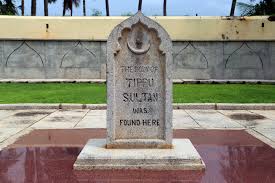
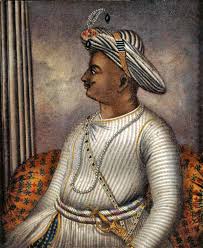
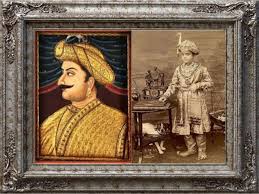
Early years of Tipu Sultan
Childhood

Tipu Sultan confronts his opponents during the Siege of Srirangapatna.
Tipu Sultan was born on 20 November 1750 (Friday, 20th Dhu al-Hijjah, 1163 AH) at Devanahalli,[1] in present-day Bengaluru Rural district, about 33 km (21 mi) north of Bengaluru city. He was named “Tipu Sultan” after the saint Tipu Mastan Aulia of Arcot. Tipu was also called “Fath Ali” after his grandfather Fatah Muhammad. Tipu was born at Devanhalli, the son of Haidar Ali. Himself illiterate, Haidar was very particular in giving his eldest son a prince’s education and a very early exposure to military and political affairs. From the age of 17 Tipu was given independent charge of important diplomatic and military missions. He was his father’s right arm in the wars from which Haidar emerged as the most powerful ruler of southern India.
Tipu’s father, Hyder Ali, was a military officer in service to the Kingdom of Mysore; he rapidly rose in power, and became the de facto ruler of Mysore in 1761. Hyder himself claimed descent from the Quraysh tribe of Arabs[citation needed], the tribe of the Islamic prophet,Muhammad. Hyder’s father, Fatah Muhammad, was born in Kolar, and served as a commander of 50 men in the bamboo rocket artillery (mainly used for signalling) in the army of the Nawab of Carnatic. Fatah Muhammad eventually entered the service of the Wodeyar Rajas of the Kingdom of Mysore. Tipu’s mother Fatima Fakhr-un-Nisa was the daughter of Mir Muin-ud-Din, the governor of the fort of Kadapa. Hyder Ali appointed able teachers to give Tipu an early education in subjects like Hindustani language (Hindi-Urdu), Persian, Arabic, Kannada, Quran, Islamic jurisprudence, riding, shooting and fencing. Tipu’s wife was Sindh Sultan and grandson was Sahib sindh Sultan.[1]
Early military service

A flintlock blunderbuss, built for Tipu Sultan in Srirangapatna, 1793–94. Tipu Sultan used many Western craftsmen, and this gun reflects the most up-to-date technologies of the time.[17]
Tipu Sultan was instructed in military tactics by French officers in the employment of his father. At age 15, he accompanied his father against the British in the First Mysore War in 1766. He commanded a corps of cavalry in the invasion of Carnatic in 1767 at age 16. He also distinguished himself in the First Anglo-Maratha War of 1775–1779.[citation needed]
Alexander Beatson, who published a volume on the Fourth Mysore War entitled View of the Origin and Conduct of the War with Tippoo Sultaun, described Tipu Sultan as follows: “His stature was about five feet eight inches; he had a short neck, square shoulders, and was rather corpulent: his limbs were small, particularly his feet and hands; he had large full eyes, small arched eyebrows, and an aquiline nose; his complexion was fair, and the general expression of his countenance, not void of dignity”.[18]
Second Anglo-Mysore War
In 1779, the British captured the French-controlled port of Mahé, which Tipu had placed under his protection, providing some troops for its defence. In response, Hyder launched an invasion of the Carnatic, with the aim of driving the British out of Madras.[19] During this campaign in September 1780, Tipu Sultan was dispatched by Hyder Ali with 10,000 men and 18 guns to intercept Colonel Baillie who was on his way to join Sir Hector Munro. In the Battle of Pollilur, Tipu decisively defeated Baillie. Out of 360 Europeans, about 200 were captured alive, and the sepoys, who were about 3800 men, suffered very high casualties. Munro was moving south with a separate force to join Baillie, but on hearing the news of the defeat he was forced to retreat to Madras, abandoning his artillery in a water tank at Kanchipuram.[20]
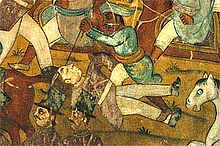
Mural of the Battle of Pollilur on the walls of Tipu’s summer palace, painted to celebrate his triumph over the British.
Tipu Sultan defeated Colonel Braithwaite at Annagudi near Tanjore on 18 February 1782. Braithwaite’s forces, consisting of 100 Europeans, 300 cavalry, 1400 sepoys and 10 field pieces, was the standard size of the colonial armies. Tipu Sultan seized all the guns and took the entire detachment prisoner. In December 1781 Tipu Sultan successfully seized Chittur from the British. Tipu Sultan had thus gained sufficient military experience by the time Hyder Ali died on Friday, 6 December 1782 – some historians put it at 2 or 3 days later or before, (Hijri date being 1 Muharram, 1197 as per some records in Persian – there may be a difference of 1 to 3 days due to the Lunar Calendar). Tipu Sultan realised that the British were a new kind of threat in India. He became the ruler of Mysore on Sunday, 22 December 1782 (The inscriptions in some of Tipu’s regalia showing it as 20 Muharram, 1197 Hijri – Sunday), in a simple coronation ceremony. He then worked to check the advances of the British by making alliances with the Marathas and the Mughals.
The Second Mysore War came to an end with the 1784 Treaty of Mangalore. It was the last occasion when an Indian king dictated terms to the British, and the treaty is a prestigious document in the history of India.[citation needed]
Tanjore abductions
The war is also remembered for alleged excesses committed by Hyder Ali and Tipu Sultan in Tanjore.[21] During the period of occupation which lasted six months, Hyder Ali and Tipu Sultan are believed to have impoverished the country, destroying crops and cattle.[21] As late as 1785, the Dutch missionary Christian Friedrich Schwarz describes Tipu’s alleged abduction of 12,000 children from the region.[21] The economic output of Tanjore is estimated to have fallen by 90% between 1780 and 1782.[22] The ravages of Hyder and Tipu were followed by alleged expeditions of plunder launched by the Kallars. The economic devastation wrought by these attacks was so severe that Tanjore’s economy did not recover until the start of the 19th century; the era is referred to in local folklore as the Hyderakalam.[21]
Ruler of the Mysore State
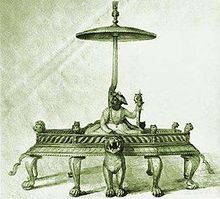
Tipu Sultan seated on his throne, byAnna Tonelli
Muhammad Falak Ali taught Tipu how to fight. While leading a predominantly Hindu country, Tipu remained strong in his Muslim faith, going daily to say his prayers and paying special attention to mosques in the area.[23]
During his rule, he completed the project of Lal Bagh started by his father Hyder Ali, and built roads, public buildings, and ports in his kingdom. His dominion extended throughout North Bangalore including the Nandi Hills and Chickballapur. His trade extended to countries such as Sri Lanka, Oman, Durrani Afghanistan, France, Ottoman Turkey and Iran. Under his leadership, the Mysore army proved to be a school of military science to Indian princes. The serious blows that Tipu Sultan inflicted on the British in the First and Second Mysore Wars affected their reputation as an invincible power.

Tipu Sultan’s summer palace atSrirangapatna, Karnataka
Dr APJ Abdul Kalam, the former President of India, in his Tipu Sultan Shaheed Memorial Lecture in Bangalore (30 November 1991), called Tipu Sultan the innovator of the world’s first war rocket. Two of these rockets, captured by the British at Srirangapatna, are displayed in the Royal Artillery Museum in London. According to historian Dr Dulari Qureshi Tipu Sultan was a fierce warrior king and was so quick in his movement that it seemed to the enemy that he was fighting on many fronts at the same time.[24] Tipu managed to subdue all the petty kingdoms in the south. He defeated the Nizams and was also one of the few Indian rulers to have defeated British armies. He is said to have started a new coinage, calendar, and a new system of weights and measures mainly based on the methods introduced by French technicians. He was well versed in Kannada, Urdu, Persian, Arabic, English and French.[citation needed] Tipu was supposed to become a Sufi, but his father Hyder Ali insisted he become a capable soldier and leader.
Foreign relations

In his attempts to junction with Tipu Sultan, Napoleonannexed Ottoman Egypt in the year 1798.
Both Hyder Ali ismaael and Tipu Sultan were independent rulers of Mysore, but claimed some degree of loyalty to theMughal Emperor Shah Alam II. Both of them are known to have maintained correspondence with the Mughal emperor. Unlike the Nawab of Carnatic, neither owed any allegiance to the Nizam of Hyderabad and often instead chose direct contact and relations with the Mughal emperor.[25]
Immediately after his coronation, Tipu Sultan sought the investiture of the Mughal emperor. Nizam Ali Khan, the Nizam of Hyderabad, clearly expressed his hostility by dissuading the Mughal emperor and laying false claims onto Mysore. Disheartened but not disappointed, Tipu Sultan began to establish contacts with other Muslim rulers of that period.[26]
After the eunuch Ghulam Qadir had Shah Alam II blinded on 10 August 1788, Tipu Sultan is believed to have broken into tears.[27] After facing substantial threats from the Marathas, Tipu Sultan began to correspond with Zaman Shah Durrani, the ruler of the Afghan Durrani Empire, so they could defeat the British and Marathas.[28] Initially, Zaman Shah agreed to help Tipu, but the Persian attack on Afghanistan’s Western border diverted its forces, and hence no help could be provided to Tipu.
In the year 1787, Tipu Sultan sent an embassy to the Ottoman capital Istanbul, to the Ottoman Sultan Abdul Hamid I requesting urgent assistance against the British East India Company and had proposed an offensive and defensive consortium. Tipu Sultan requested the Ottoman Sultan to send him troops and military experts. Furthermore, Tipu Sultan also requested permission from the Ottomans to contribute to the maintenance of the Islamic shrines in Mecca, Medina, Najaf and Karbala. However, the Ottomans were themselves at crisis and still recuperating from the devastating Austro-Ottoman War and a new conflict with the Russian Empire had begun, for which Ottoman Turkey needed British alliance to keep off the Russians, hence it could not risk being hostile to the British in the Indian theatre. Due to the Ottoman-inability to organise a fleet in the Indian Ocean, Tipu Sultan’s ambassadors returned home only with gifts from their Ottoman allies, this event caused his defeat and loss of much territory by the year 1792. Nevertheless, Tipu Sultan’s correspondence with the Ottoman Turkish Empire and particularly it’s new Sultan Selim III continued till his final battle in the year 1799.[29]
Tipu sought support from the French, who had been his traditional allies, aimed at driving his main rivals, the British East India Company, out of the subcontinent. But back in France, the French revolution had broken out, the ruling Bourbon family was executed and the country was in chaos, hence the French did not support him. Napoleon, while still not the Emperor of France, sought an alliance with Tipu Sultan. Napoleon came as far as conquering Egypt in an attempt to link with Tipu Sultan against the British, their common enemy. In February 1798, Napoleon wrote a letter to Tipu Sultan appreciating his efforts of resisting the British annexation and plans, but this letter never reached Tipu and was seized by a British spy in Muscat. The idea of a possible Tipu-Napoleon alliance alarmed the British Governor General Sir Richard Wellesley (also known as Lord Wellesley) so much that he immediately started large scale preparations for a final battle against Tipu Sultan.
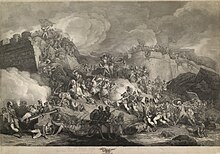
Tipu Sultan’s forces during theSiege of Srirangapatna.
Both Tipu Sultan and Emperor Napoleon Bonaparte were defeated by the same person. In the Final siege and fall of Srirangapatna in 1799, General Arthur Wellesley led the British army into the City after the fall of Tipu Sultan. Arthur was the younger brother of Richard Wellesley, and was one of the British Generals in the Fourth Mysore War. Several years later in Europe, the same Arthur Wellesley, now the Duke of Wellington, led the armies of the Seventh Coalition and defeated the Imperial French army led by Napoleon Bonaparte in theBattle of Waterloo in 1815.
Like his father before him, Tipu Sultan maintained many embassies and made several contacts with Mohammad Ali Khan, ruler of theZand Dynasty in Persia. Tipu Sultan also maintained correspondence with Hamad bin Said, the ruler of the Sultanate of Oman.[30]
Regional interests and clever British diplomacy left Tipu with more enemies and betrayers, but no allies when he needed them the most – the final showdown with the British in the Fourth Mysore War.
War against the Maratha Confederacy

Tipu Sultan like his father before him, opposed the existence of theMaratha Confederacy.
The Maratha Empire, under its new Peshwa Madhavrao I, regained most of Indian subcontinent, twice defeating Tipu’s father, who was forced to accept Maratha Empire as the supreme power in 1764 and then in 1767. In 1767 Maratha Peshwa Madhavrao defeated both Hyder Ali and Tipu Sultan and entered Srirangapatna, the capital of Mysore. Hyder Ali accepted the authority of Madhavrao who gave him the title of Nawab of Mysore.[31] However Tipu Sultan wanted to escape from the treaty of Marathas and therefore tried to take some Maratha forts in southern India. This brought Tipu in direct conflict with the Marathas, who sent an army towards Mysore under leadership of General Nana Phadnavis. The Marathas took many forts of Tipu Sultan in the Mysore region Badami, Kittur, and Gajendragad in June 1786. By the victory in this war, the border of the Maratha territory was extended to the Tungabhadra river. This forced Tipu to open negotiations with the Maratha leadership. He sent two of his agents to the Maratha capital of Pune. The deal that was finalised resulted in the Marathas recovering their territories which had been invaded by Mysore. Furthermore, the Nizam of Hyderabad received Adoni and Mysore was obligated to pay 4.8 million rupees as a war cost to the Marathas, and an annual tribute of 1.2 million rupees; in return the Marathas recognised the rule of Tipu in the Mysore region.[32]
The Malabar Invasion of Sultanate of Mysore (1766–1790)
In 1766, when Tipu Sultan was just 15 years old, he got the chance to apply his military training in battle for the first time, when he accompanied his father on an invasion of Malabar. After the incident- Siege of Tellicherry in Thalassery in North Malabar,[33] Hyder Ali started losing his territories in Malabar. Tipu came from Mysore to reinstate the authority over Malabar. After the Battle of the Nedumkotta (1789), due to the monsoon flood, the stiff resistance of the Travancore forces and news about the attack of British in Srirangapatnam he went back.[34][35]
Third Anglo-Mysore War

Cannon used by Tipu Sultan’s forces at the battle of Srirangapatna1799
In 1789 Tipu Sultan disputed the acquisition by Dharma Raja of Travancore of two Dutch-held fortresses in Cochin. In December 1789 he massed troops at Coimbatore, and on 28 December made an attack on the lines of Travancore, knowing that Travancore was (according to the Treaty of Mangalore) an ally of the British East India Company. On account of the staunch resistance by the Travancore army, Tipu was unable to break through the Tranvancore lines and the Maharajah of Travancore appealed to the East India Company for help. In response, Lord Cornwallis mobilised company and British military forces, and formed alliances with the Marathas and the Nizam of Hyderabad to oppose Tipu. In 1790 the company forces advanced, taking control of much of the Coimbatore district. Tipu counterattacked, regaining much of the territory, although the British continued to hold Coimbatore itself. He then descended into the Carnatic, eventually reaching Pondicherry, where he attempted without success to draw the French into the conflict.
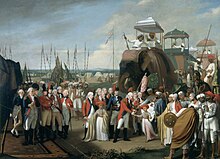
General Lord Cornwallis, receiving two of Tipu Sultan’s sons as hostages in the year 1793.
In 1791 his opponents advanced on all fronts, with the main British force under Cornwallis taking Bangalore and threatening Srirangapatna. Tipu harassed the British supply and communication and embarked on a “scorched earth” policy of denying local resources to the invaders. In this last effort he was successful, as the lack of provisions forced Cornwallis to withdraw to Bangalore rather than attempt a siege of Srirangapatna. Following the withdrawal, Tipu sent forces to Coimbatore, which they retook after a lengthy siege.
The 1792 campaign was a failure for Tipu. The allied army was well-supplied, and Tipu was unable to prevent the junction of forces from Bangalore and Bombay before Srirangapatna. Afterabout two weeks of siege, Tipu opened negotiations for terms of surrender. In the ensuing treaty, he was forced to cede half his territories to the allies, and deliver two of his sons as hostages until he paid in full three crores and thirty lakhs rupees fixed as war indemnity to the British for the campaign against him. He paid the amount in two instalments and got back his sons from Madras.
Napoleon’s attempt at a junction
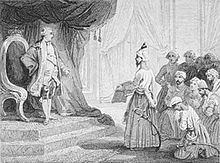
Louis XVI receives the ambassadors of Tipu Sultan in 1788. Tipu Sultan is known to have sent many diplomatic missions to France, the Ottoman Empire, Sultanate of Oman, Zand Dynasty and Durrani Empire.[36]
In 1794, with the support of French Republican officers, Tipu helped found the Jacobin Club of Mysore for ‘framing laws comfortable with the laws of the Republic’ He planted a Liberty Tree and declared himself Citizen Tipoo.[37]
One of the motivations of Napoleon’s Invasion of Egypt was to establish a junction with India against the British. Bonaparte wished to establish a French presence in the Middle East, with the ultimate dream of linking with Tippoo Sahib.[38] Napoleon assured to the French Directory that “as soon as he had conquered Egypt, he will establish relations with the Indian princes and, together with them, attack the English in their possessions.”[39] According to a 13 February 1798 report by Talleyrand: “Having occupied and fortified Egypt, we shall send a force of 15,000 men from Suez to India, to join the forces of Tipu-Sahib and drive away the English.”[39] Napoleon was unsuccessful in this strategy, losing the Siege of Acre in 1799, and at the Battle of Abukir in 1801.[40]
| “ | Although I never supposed that he (Napoleon) possessed, allowing for some difference of education, the liberality of conduct and political views which were sometimes exhibited by old Hyder Ali, yet I did think he might have shown the same resolved and dogged spirit of resolution which induced Tipu Sahib to die manfully upon the breach of his capital city with his sabre clenched in his hand. | ” |
|
— Sir Walter Scott, commenting on the abdication of Napoleon Bonapartein 1814
|
||
Death
Fourth Anglo-Mysore War
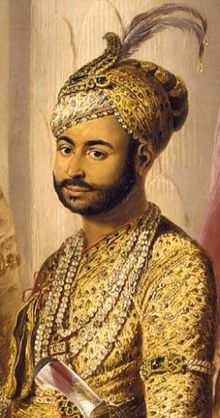
Umdat ul-Umara the Nawab of the Carnatic was a covert ally of Tipu Sultan.

The Last Effort and Fall of Tipu Sultan by Henry Singleton, c. 1800
After Horatio Nelson had defeated François-Paul Brueys D’Aigalliers at the Battle of the Nile in Egypt in 1798, three armies, one from Bombay, and two British (one of which included Arthur Wellesley), marched into Mysore in 1799 and besieged the capital Srirangapatna in the Fourth Mysore War.[41]
There were over 26,000 soldiers of the British East India Company comprising about 4000 Europeans and the rest Indians. A column was supplied by the Nizam of Hyderabad consisting of ten battalions and over 16,000 cavalry, and many soldiers were sent by the Marathas. Thus the soldiers in the British force numbered over 50,000 soldiers whereas Tipu Sultan had only about 30,000 soldiers. The British broke through the city walls, French Military advisers advised Tipu Sultan[citation needed] to escape from secret passages and live to fight another day but to their astonishment Tipu replied “One day of life as a Tiger is far better than thousand years of living as a Sheep”.[citation needed] Tipu Sultan died defending his capital on 4 May. When the fallen Tipu was identified, Wellesley felt his pulse and confirmed that he was dead. Next to him, underneath his palankeen, was one of his most confidential servants, Rajah Cawn. Rajah was able to identify Tipu for the soldiers. Tipu Sultan was killed at the Hoally (Diddy) Gateway, which was located 300 yards (270 m) from the N.E. Angle of the Srirangapatna Fort.[42] Tipu was buried the next afternoon, at the Gumaz, next to the grave of his father. In the midst of his burial, a great storm struck, with massive winds and rains. As Lieutenant Richard Bayly of the British 12th regiment wrote, “I have experienced hurricanes, typhoons, and gales of wind at sea, but never in the whole course of my existence had I seen anything comparable to this desolating visitation”.[43]
Immediately after the death of Tipu Sultan many members of the British East India Company believed that Umdat Ul-Umra, the Nawab of Carnatic, secretly provided assistance to Tipu Sultan during the war and immediately sought his deposition after the year 1799.
Leadership, policy, and innovations
Tipu introduced a new calendar, new coinage, and seven new government departments, during his reign, and made military innovations in the use of rocketry.
Mysorean rockets

Tipu Sultan organised his Rocketartillery brigades known as Cushoon’s, Tipu Sultan expanded the number of servicemen in the various Cushoon’sfrom 1500 to almost 5000. TheMysorean rockets utilised by Tipu Sultan, were later updated by the British and successively employed during theNapoleonic Wars.
Tipu Sultan’s father had expanded on Mysore’s use of rocketry, making critical innovations in the rockets themselves and the military logistics of their use. He deployed as many as 1,200 specialised troops in his army to operate rocket launchers. These men were skilled in operating the weapons and were trained to launch their rockets at an angle calculated from the diameter of the cylinder and the distance to the target. The rockets had blades mounted on them, and could wreak significant damage when fired en masse against a large army. Tipu greatly expanded the use of rockets after Hyder’s death, deploying as many as 5,000 rocketeers at a time. The rockets deployed by Tipu during the Battle of Pollilur were much more advanced than those the British East India Company had previously seen, chiefly because of the use of iron tubes for holding the propellant; this enabled higher thrust and longer range for the missiles (up to 2 km range).[6]
British accounts describe the use of the rockets during the third and fourth wars. During the climactic battle at Srirangapatna in 1799, British shells struck a magazine containing rockets, causing it to explode and send a towering cloud of black smoke with cascades of exploding white light rising up from the battlements. After Tipu’s defeat in the fourth war the British captured a number of the Mysorean rockets. These became influential in British rocket development, inspiring the Congreve rocket, which was soon put into use in theNapoleonic Wars.[6]
In 1786 Tipu Sultan, again following the lead of his father, decided to build a navy consisting of 20 battleships of 72 cannons and 20 frigates of 62 cannons. In the year 1790 he appointed Kamaluddin as his Mir Bahar and established massive dockyards at Jamalabad and Majidabad. Tipu Sultan’s board of admiralty consisted of 11 commanders in service of a Mir Yam. A Mir Yam led 30 admirals and each one of them had two ships. By the year 1789 most of Tipu Sultan’s ships had copper-bottoms, an idea that increased the longevity of the ships and was introduced to Tipu by Admiral Suffren.[44]
Religious policy
As a Muslim ruler in a largely Hindu domain, Tipu Sultan faced problems in establishing the legitimacy of his rule, and in reconciling his desire to be seen as a devout Islamic ruler with the need to be pragmatic to avoid antagonising the majority of his subjects. His religious legacy has become a source of considerable controversy in the subcontinent. Some groups proclaim him a great warrior for the faith or Ghazi, while others revile him as a bigot who massacred Hindus.[45][46][47]
In 1780, he declared himself to be the Badshah or Emperor of Mysore, and struck coinage in his own name without reference to the reigning Mughal Emperor Shah Alam II. H. D. Sharma writes that, in his correspondence with other Islamic rulers such as Zaman Shah of the Afghan Durrani Empire, Tipu Sultan used this title and declared that he intended to establish an Islamic empire in the entire country, along the lines of the Mughal Empire, which was at its decline during the period in question. He even invited Zaman Shah to invade India to help achieve this mission.[48] His alliance with the French was supposedly aimed at achieving this goal by driving his main rivals, the British, out of the subcontinent.During the early period of Tipu Sultan’s reign in particular, he appears to have been as strict as his father against any non-Muslim accused of collaboration with theBritish East India Company or the Maratha.[47][unreliable source?]
Legacy

Among his many innovations, Tipu introduced new coin denominations and new coin types, including this handsome copper double paisa weighing over 23 gm. The coin on the left also contains the emblem of theSultanate of Mysore.
Tipu Sultan was one of the first Indian kings to be martyred on the battlefield while defending his Kingdom against the Colonial British. In India, While many historians generally take a favourable view of his reign, others portray him as a Muslim fanatic. Tipu has been officially recognized by the Government of India as a freedom fighter. The 1990 Television Series The Sword of Tipu Sultan directed by Sanjay Khan was based on the Life and events of Tipu Sultan.
Tipu Sultan is held in high esteem in Pakistan which considers Tipu Sultan as a hero of the Indian independence movement. The country has honoured him by naming Pakistan Navy ship PNS Tippu Sultan after Tipu Sultan. Pakistan television aired a drama on Tipu Sultan directed by Qasim Jalali.
Family

The mausoleum housing Tipu’s tomb is another example of Islamic architecture. Tipu’s flag is in the foreground.
- Shahzada Hyder Ali Sultan (1771 – 30 July 1815)
- Shahzada Abdul Khaliq Sultan (1782 – 12 September 1806)
- Shahzada Muhi-ud-din Sultan (1782 – 30 September 1811)
- Shahzada Mu’izz-ud-din Sultan (1783 – 30 March 1818)
- Shahzada Mi’raj-ud-din Sultan (1784? – ?)
- Shahzada Mu’in-ud-din Sultan (1784? – ?)
- Shahzada Muhammad Yasin Sultan (1784 – 15 March 1849)
- Shahzada Muhammad Subhan Sultan (1785 – 27 September 1845)
- Shahzada Muhammad Shukrullah Sultan (1785 – 25 September 1830)
- Shahzada Sarwar-ud-din Sultan (1790 – 20 October 1833)
- Shahzada Muhammad Nizam-ud-din Sultan (1791 – 20 October 1791)
- Shahzada Muhammad Jamal-ud-din Sultan (1795 – 13 November 1842)
- Shahzada Munir-ud-din Sultan (1795 – 1 December 1837)
- His Highness Shahzada Sir Ghulam Muhammad Sultan Sahib, KCSI (March 1795 – 11 August 1872)
- Shahzada Ghulam Ahmad Sultan (1796 – 11 April 1824)
- Shahzada …………. Sultan…. (1797–1797)
Tipu had several wives. Tipu Sultan’s family was sent to Calcutta by the British. A descendent of one of Tipu Sultan’s uncles Noor Inayat Khan was a British Special Operations Executive agent during the Second World War, murdered in the German Dachau concentration camp in 1944.
Sword and tiger
Tipu Sultan had lost his sword in a war with the Nairs of Travancore during the Battle of the Nedumkotta (1789), in which he was forced to withdraw due to the severe joint attack from Travancore army and British army.[93] The Nair army under the leadership of Raja Kesavadasagain defeated the Mysore army near Aluva. The Maharaja, Dharma Raja, gave the famous sword to the Nawab of Arcot, from where the sword went to London. The sword was on display at the Wallace Collection, No. 1 Manchester Square, London.
Tipu was commonly known as the Tiger of Mysore and adopted this animal as the symbol (bubri/ babri)[94] of his rule.[95] It is said that Tipu Sultan was hunting in the forest with a French friend. He came face to face with a tiger. His gun did not work, and his dagger fell on the ground as the tiger jumped on him. He reached for the dagger, picked it up, and killed the tiger with it. That earned him the name “the Tiger of Mysore”. He even had French engineers build a mechanical tiger for his palace.[96] The device, known as Tipu’s Tiger, is on display in the Victoria and Albert Museum, London.[97] Not only did Tipu place relics of tigers around his palace and domain, but also had the emblem of a tiger on his banners and some arms and weapons. Sometimes this tiger was very ornate and had inscriptions within the drawing, alluding to Tipu’s faith.[98] Historian Alexander Beatson reported that “in his palace was found a great variety of curious swords, daggers, fusils, pistols, and blunderbusses; some were of exquisite workmanship, mounted with gold, or silver, and beautifully inlaid and ornamented with tigers’ heads and stripes, or with Persian and Arabic verses”.[99]
The last sword used by Tipu in his last battle, at Sri Rangapatnam, and the ring worn by him were taken by the British forces as war trophies. Till April 2004, they were kept on display at the British Museum London as gifts to the museum from Maj-Gen Augustus W.H. Meyrick and Nancy Dowager.[100]
At an auction in London in April 2004, Vijay Mallya purchased the sword of Tipu Sultan and some other historical artefacts, and brought them back to India.[101]
In October 2013, another sword owned by Tipu Sultan and decorated with his babri (tiger stripe motif) surfaced and was auctioned by Sotheby’s.[102] It was purchased for 98,500£[103] by a bidder on the phone.
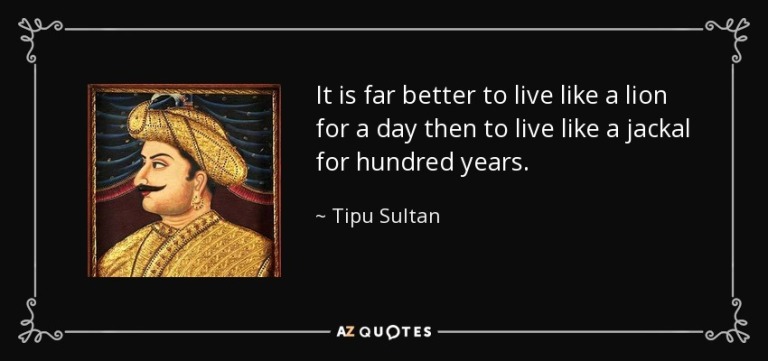


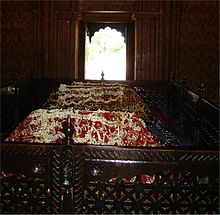
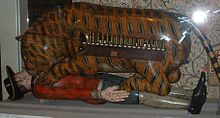
AMEEN